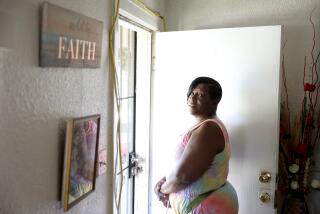Where Do Former Foster Children Go?
- Share via
Foster children are forced to leave the security of state care when they turn 18 or graduate from high school. These teen-agers are expected to get a job, find a place to live and immediately make the shift to independent living whether they are ready or not.
They need help, particularly with housing. As many as 35% of former foster children are homeless, according to a national study released two months ago.
A former foster child who had become homeless sued the state of New York for failing to provide adequate vocational training and the skills needed for independent living. The court ordered the state to provide shelter for the young man until he was 21. The decision also prompted federal funding for programs to teach independent living skills to foster children.
But federal funds for low-income housing have been shrinking. The average cost of a one-bedroom apartment is $600 in Los Angeles. Most young workers do not earn enough income--typically three times the amount of the rent--to qualify for those apartments. Many former foster children are also turned down because they lack sufficient job and credit histories.
The Los Angeles Board of Supervisors is expected to provide some assistance today. Retiring Supervisor Pete Schabarum, a strong advocate for foster children, has asked his colleagues to approve the use of federal housing funds for a $1.2- million transitional shelter.
The Foster Youth Connection, an advocacy group, proposed the temporary housing, which will be located on surplus county land near Pico Rivera. The county home will offer shelter and other services to provide a bridge to independent living for three dozen former foster children. The advocacy group is also working with the city to set up a smaller home in South-Central Los Angeles. These projects are an important start to solving a much bigger problem.
Nearly 1,200 teen-agers leave foster care every year in Los Angeles. Many have benefitted from a county program that teaches older foster children how to look for a job, how to find an apartment, how to budget and other skills. But some foster teens need more help.
Although at least 100 Los Angeles County foster children win scholarships to college or vocational schools every year, the majority are expected to provide for themselves. Some lack high school diplomas or have emotional problems that complicate their bid for independence.
Without help, too many foster teens wind up joining the ranks of the unemployed or homeless. Then they become a more costly societal problem. The board would be wise to extend a helping hand while kids who need help can still grab hold.
More to Read
Sign up for Essential California
The most important California stories and recommendations in your inbox every morning.
You may occasionally receive promotional content from the Los Angeles Times.













